#frankfurt motor show
Text


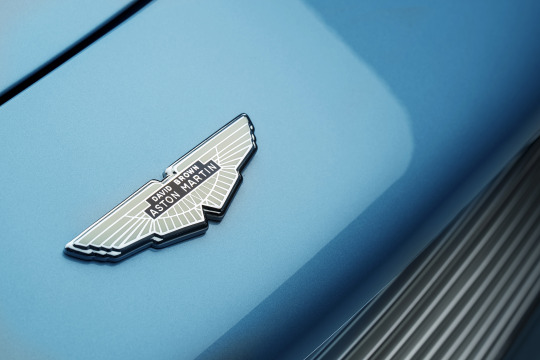


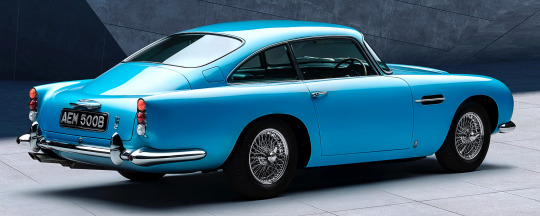
Aston Martin DB5, 1963. This week marks 60 years since the introduction of the DB5. Making its official public debut at the Frankfurt Motor Show in September 1963 the newcomer featured several design, technical and equipment changes over its predecessor – most notably a major engine development delivering more power
#Aston Martin#Aston Martin DB5#1963#60th Anniversary#IAA#Frankfurt Motor Show#straight 6#sports coupé#60th birthday#DB5
1K notes
·
View notes
Photo

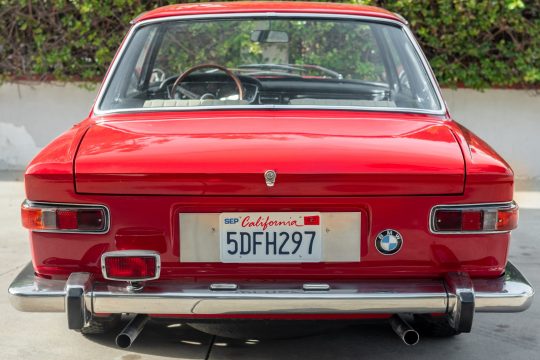




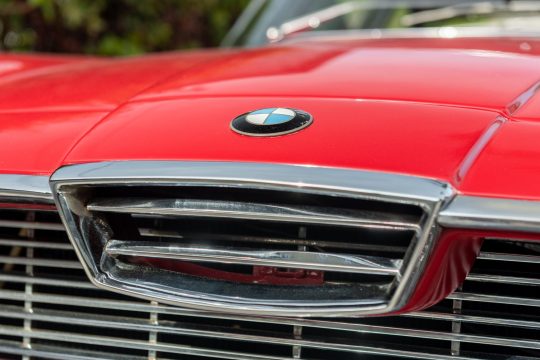

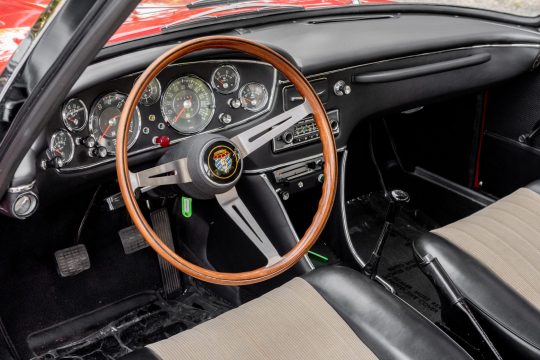

BMW-Glas 3000 V8
This 1968 BMW-Glas 3000 V8 is one of 389 examples built between 1967 and 1968 following BMW’s acquisition of Hans Glas GmbH, and is said to have spent time in a museum in Germany before being imported to the US by a previous owner. Finished in red over two-tone upholstery with corduroy seat inserts, it is powered by a 3.0-liter V8 paired with a four-speed manual transmission and equipped with four-wheel disc brakes, electronic ignition, and a Becker radio.
The Glas V8 debuted at the 1965 Frankfurt Motor Show and featured 2+2 coupe bodywork styled by Italian designer Pietro Frua. After taking over operations of Hans Glas GmbH in 1966, BMW continued to produce the model as the BMW-Glas 3000 V8 from September 1967 to May 1968 using their own badging. This example was refinished in its current red under previous ownership and features a fender-mounted Talbot mirror along with front and rear fog lamps.
he 2,982cc V8 was developed by Glas and features a belt-driven overhead camshaft on each cylinder bank as well as a triple-barrel downdraft carburetor and Glas-branded valve covers.
65 notes
·
View notes
Text

BMW the bubble, Frankfurt Motor Show (1999)
2K notes
·
View notes
Text


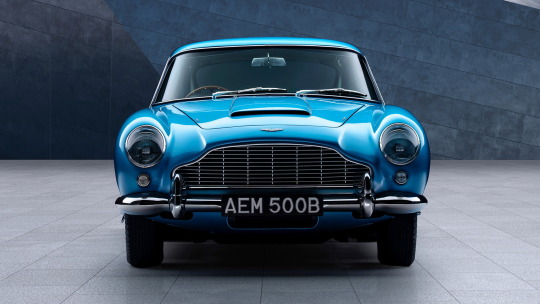


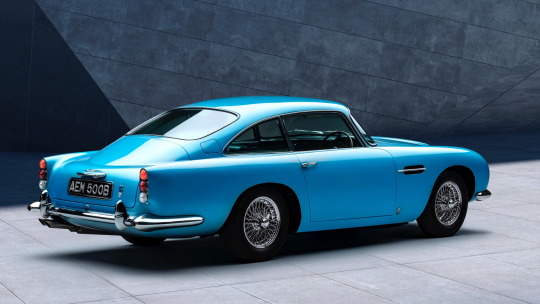





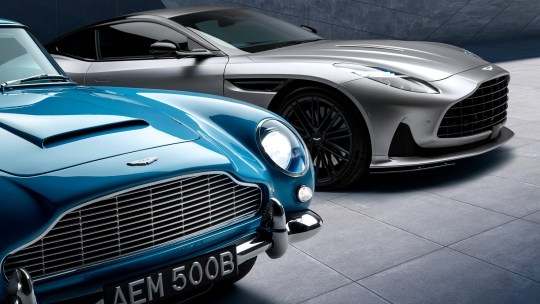

Iconic Aston Martin DB5 Turns 60 !
Is there a more famous car on the planet? The tifosi may proffer a scarlet Ferrari, Brits may suggest the Mini and the French will surely put forward a 2CV or similar. But for many, the Aston Martin DB5 is the most famous car of all, spilling from popular culture into mainstream consciousness.
We’ll even allow the use of the overused epithet ‘iconic’ to describe James Bond’s most memorable transport.
The two-doors coupe was first shown at the 1963 Frankfurt motor show, a point not lost on us as we return from this autumn’s Munich Motoe Show, the German salon’s successor. It must’ve been one helluva show six decades ago; the Porsche 911 was also unleashed to the world at the IAA that same year.
In all, a mere 887 coupes, 123 convertibles, and 12 shooting brakes were built. Even by the standards of the day, the numbers were tiny, especially considering total U.K. car production in 1963 alone was more than 1.8 million units, according to Aston Martin.
(1963, Aston Martin DB5 & Aston Martin DB5 poses with DB12 for its 60th birthday)
#art#design#luxury cars#supercars#sport cars#luxurycars#supercar#luxurylifestyle#luxurycar#vintage cars#aston martin#aston martin DB5#DB5#DB12#luxury car#iconic car#1963#mid century#happy brthday#classic cars
168 notes
·
View notes
Note
That anon acting like being a journalist in motorsport is like being an executive in a capitalist establishment. 🤡 It’s like accusing a McDonalds crew member of being pro capitalism because they work in McDonalds. Like??? As if being treated poorly and paid dirt despite working your ass off everyday is not reason enough to he a socialist. I am a socialist precisely because of my experience as a worker in these filthy corporations! Clown anon!
you're absolutely right but a very large number of people in motorsport and the media are obviously very right wing. even when it's wildly against their own interests or totally in opposition to the concept of journalism or whatever.
especially in worlds like motorsport or the car industry. a lot of people don't like actually covering things, they enjoy being there. whether that's at the Frankfurt motor show or the Miami Grand Prix. and if your goal is just being there then you're willing to work for places where you do actively bad stuff because what you make was never the goal.
that's not how it's ever worked for me and this isn't meant to sound morally superior or whatever because honestly, get what you want i guess. but for me being in paddocks or factories or literally driving cars is so that I can write better pieces and find out more. the pass is to make the media, not the pieces a bartering chip for the pass.
in retrospect, some of that is why it was often pretty lonely. because I wasn't playing the same game as quite a lot of people. and it also makes the industry all the more exploitative because people want that lanyard so much they'll do anything for it.
I was thinking the other day that there's been almost no coverage of the investigation into F1 lobbying the EU and British government on behalf of Aramco, via synthetic fuel. It's a really damning link and I'm not just saying this because I'm quoted in the article but I would absolutely be writing about it if I still had somewhere to do it. it's a really shocking scandal, that F1 is helping hold up combustion car bans by contributing (unproven) information about synthetic fuels.
it's not the kind of thing F1 like people reporting. so suddenly all the men who self-style as hard-nosed business journalists in the paddock are being awfully quiet. because it is more important to still be there.
obviously, I am not still there. I did indeed criticise FE one too many times for their liking and fell out of favour. I am not a model for holding onto your pass. but there is also no point pretending that I could have acted differently just to keep it. anyway, this all turned into a bit of a ramble but turns out there's bad people kind of everywhere and often they're holding the controls.
I think that's part of what's upset me about the Watcher thing. these are guys who deliberately set out to make their own media company so they had that control to make things they were proud of, with the production values they wanted, under their own ownership, without having to fire people all the time. and you're asking them to be more like Buzzfeed? that was the bad old days, friends.
21 notes
·
View notes
Text
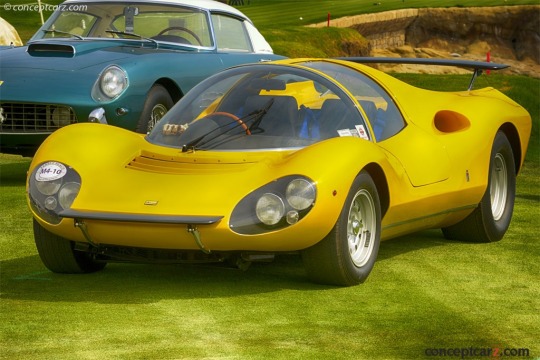
1967 Ferrari Dino 206 Competizione Competition Berlinetta
Alfredo 'Dino' Ferrari was credited with the design of the Ferrari V6 engine. With help from the legendary engineer Vittorio Jano, Dino influenced Enzo Ferrari's decision to produce racing cars in the 1950s powered by V6 and V8 engines.
Enzo Ferrari was hesitant to adapt the mid-engine layout for his customer cars, fearing they might be unsafe. He eventually relented and Sergio Pininfarina was tasked with designing a mid-engined concept for the 1965 Paris Motor Show, but demanded that it wear the Dino badge alone. At the Turin car show in 1966, the Dino 203S was well receipted and production soon followed.
The production Dino 206GT had many updates, modifications and changes such as softer edges and curving lines typical of earlier Italian cars. The 2-liter all-aluminum engine was transversely-mounted mid-ship and offered 160 horsepower. The V-6 engine featured dual overhead camshafts and 9.7:1 compression ratio. The crankshaft featured four main bearings with induction via three Weber 40 DCN/4 2-barrel carburetors. The frame of the 206GT was made from lightweight aluminum and fitted with full independent suspension. Disc brakes could be found at all four corners. The wheelbase of the car measured a short 90-inches. Top speed was a very impressive 146 mph. In total, there were only 152 examples built during 1968 and 1969.
This unique prototype followed the Dino 206 racing cars that raced at Le Mans and were powered by the Dino V6 engine. First seen at a 1966 Ferrari press conference, the standard 206 was bodied at Piero Drogo's Carrozzeria and featured light alloy bodywork and a semi-monocoque chassis. Only 18 were built, so the model was restricted to the Group 6 prototype class. This one-off 206 chassis, built by Ferrari, then went to Pininfarina to receive a new custom body. The plan was to use race-car engineering in a road-going supercar; it used an engine from one of three Dinos that raced at Le Mans in 1966. Designed by Paolo Martin, the car was shown at the 1967 Frankfurt Auto Show as a 'Dino' Berlinetta Prototype Competition, to much acclaim. Pininfarina preserved the car in their private museum until 2006, when they offered the current owner the opportunity to purchase the car and become its first owner.
#Ferrari Dino 206 Competizione Competition Berlinetta#car#cars#Ferrari Dino 206#berlinetta#ferrari dino#dino#ferrari
30 notes
·
View notes
Text

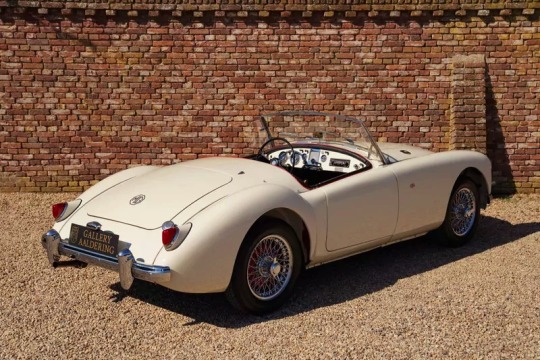
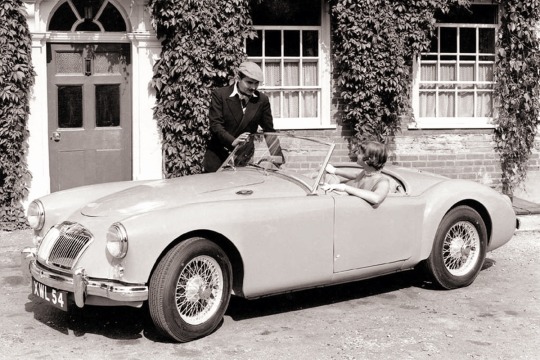


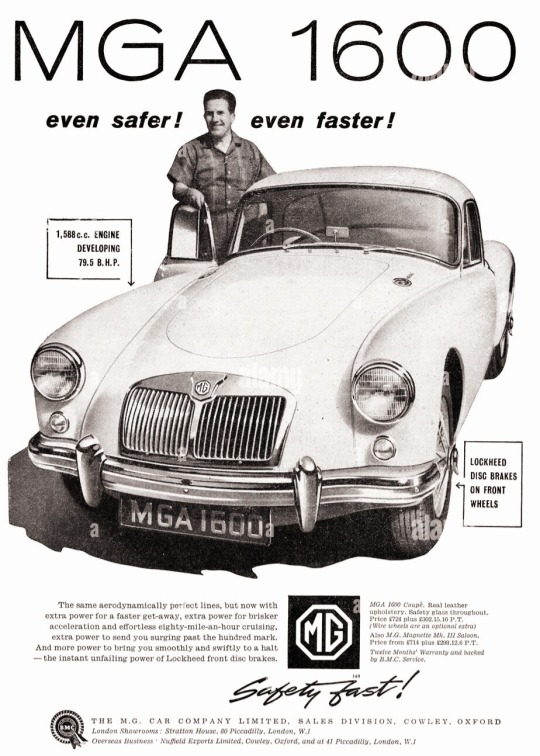
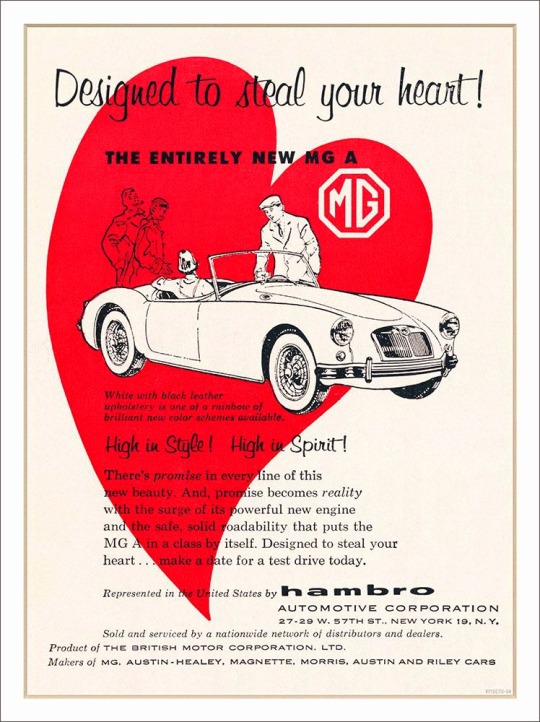

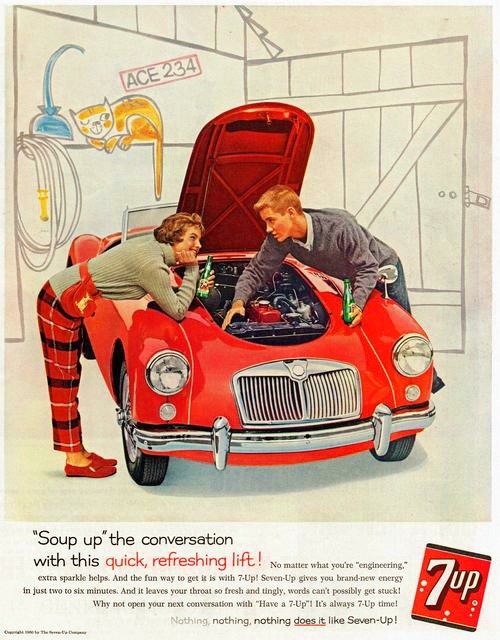
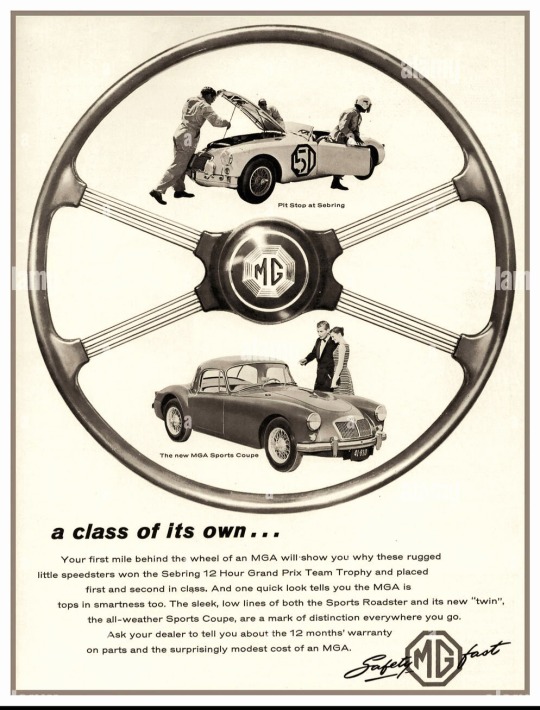
🇬🇧 Explore the captivating history of the MG MGA—a timeless classic that embodies the essence of British automotive craftsmanship! Introduced in the 1950s, the MGA made waves with its striking design and exhilarating performance, captivating drivers around the globe.
👉 The MG MGA marked a significant milestone for MG sports cars. Announced on 26 September 1955, the car was officially launched at the Frankfurt Motor Show. With its sleek contours, graceful curves, and distinctive grille, the MGA epitomized elegance and sophistication on the open road.
🛞 The MGA design dates back to 1951 when MG designer Syd Enever created a streamlined body for George Philips' TD Le Mans car. As it was so different from the older MG models, it was called the MGA, the "first of a new line" to quote the contemporary advertising. There was also a new engine available; therefore, the car did not have the originally intended XPAG unit but was fitted with the BMC B-series engine allowing a lower bonnet line.
🚗 Underneath its sleek exterior, the MGA boasted a lineup of powerful engines, delivering an unforgettable driving experience characterized by agility and precision. Whether navigating winding country roads or zipping through city streets, the MGA offered a thrilling ride that left a lasting impression.
👑 The MG MGA quickly gained iconic status, earning recognition in pop culture and becoming a symbol of automotive excellence. The MGA has been raced extensively in the U.S. since its 1955 introduction and with considerable success. In Sports Car Club of America competition, the MGA has won numerous regional and national championships.
🌟 Whether admired for its iconic aesthetics, dynamic performance, or rich heritage, the MG MGA continues to evoke passion and admiration among collectors and enthusiasts worldwide.
#brits and yanks on wheels#retro cars#transatlantic torque#vehicle#cars#old cars#brands#companies#automobile#english cars#made in uk#made in england#england#mg#mg motor#british motor corporation#british cars#british leyland#mg mga#mg rover group#sport cars#sports cars#race car#racing#sports car club of america#design#designer#championship#exterior#syd enever
9 notes
·
View notes
Text


#ferrari#ferrari 458#458 italia#ferrari 458 italia#super car#supercar#supercars#fast car#legend#italian#italian super cars#ferrari italia#italia#super cars#legendary#cars#car#luxurycars#fast cars
17 notes
·
View notes
Text
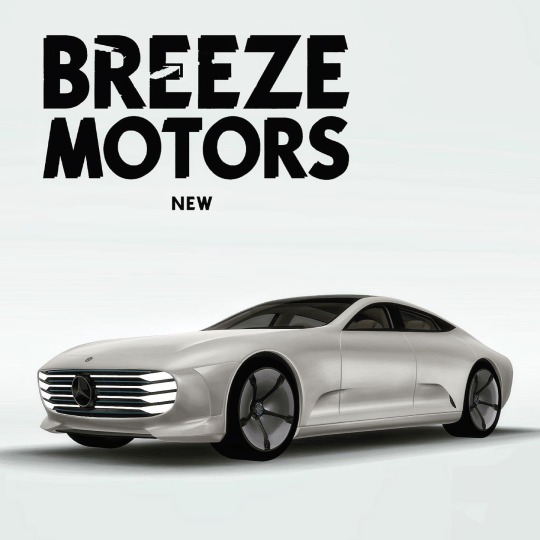
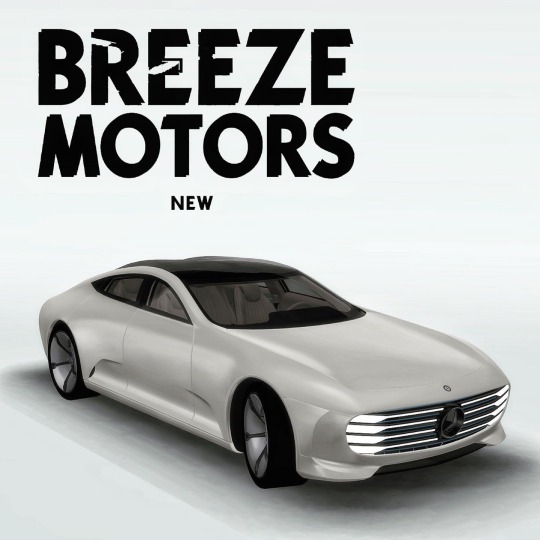
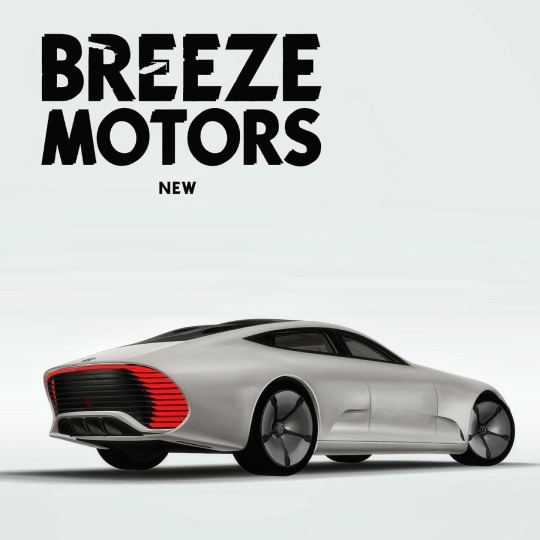
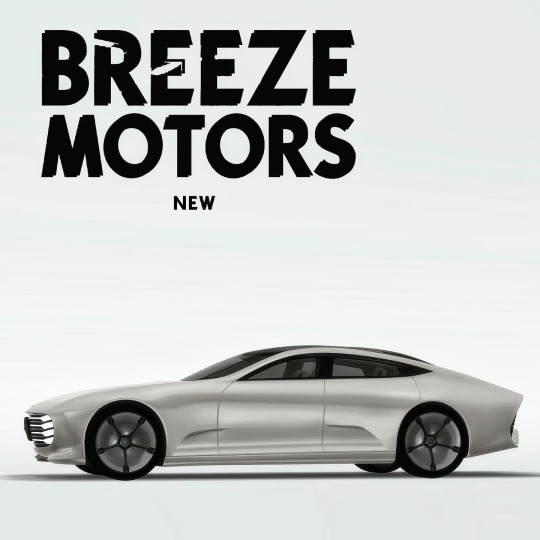
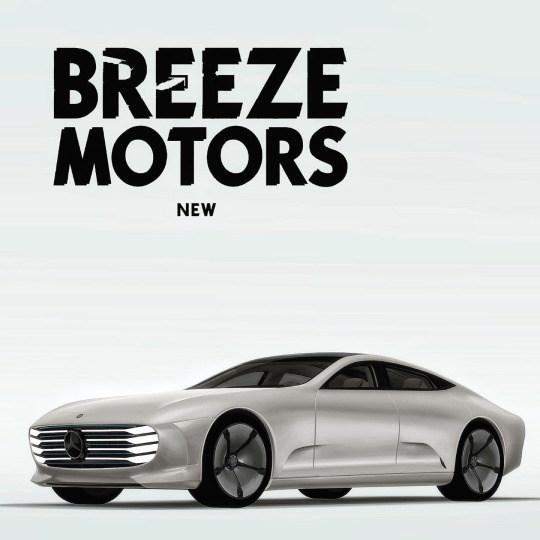
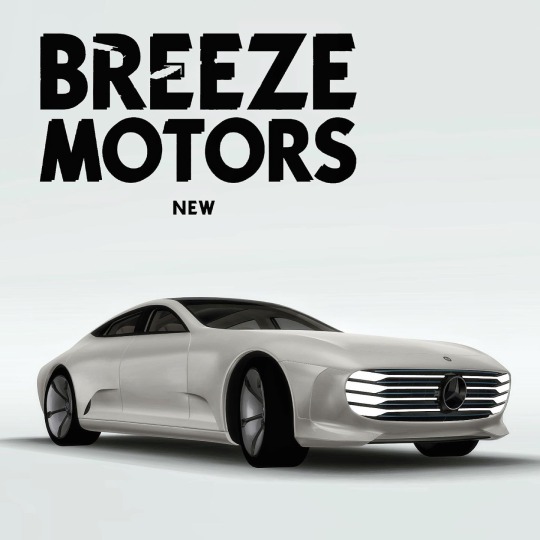
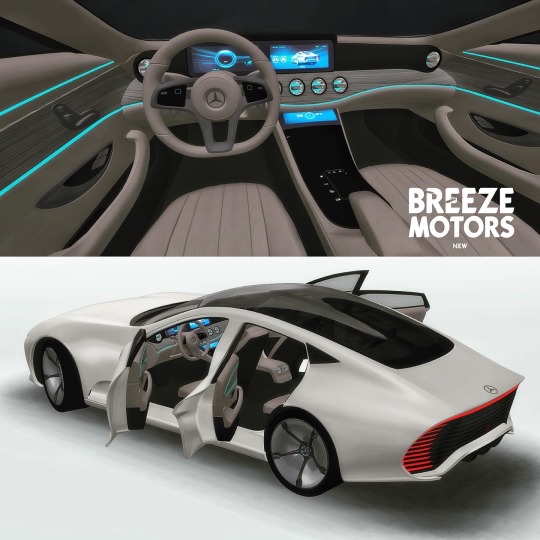
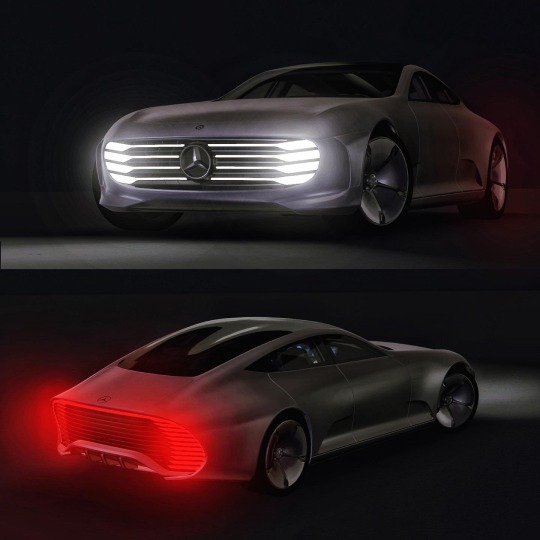
“Designing by the wind”
2015 Mercedes-Benz IAA Concept 🇩🇪
The Mercedes-Benz "Concept IAA" (Intelligent Aerodynamic Automobile) is two cars in one: an aerodynamics world champion with a Cd value of 0.19 and a four-door coupé embodying irresistible design. The study, which is celebrating its world premiere at the Frankfurt International Motor Show, switches automatically from design mode to aerodynamic mode when the vehicle reaches a speed of 80 km/h, whereby numerous aerodynamics measures alter the shape of the vehicle. Inside, the "Concept IAA" continues the design line of the S-Class and S-Class Coupé, offers new touch-based functions and provides an idea of what the interior of a business saloon might look like in the near future.
Available exclusively for “No Limits” and “All Inclusive” tiers.
Model with HQ interior, open/close doors and functional light.
Go and join my Patreon!
#the sims 4#sims 4#sims4#sims4car#the sims 4 cc#the sims 4 custom content#thesims4cars#the sims 4 cars#sims4vehicles#the sims#the sims 4 cc finds#sims 4 cc finds#the sims 5#sims 4 cars#sims 5#sims 4 cc#the sims custom content#sims 4 alpha cc#sims#mercedes
28 notes
·
View notes
Photo
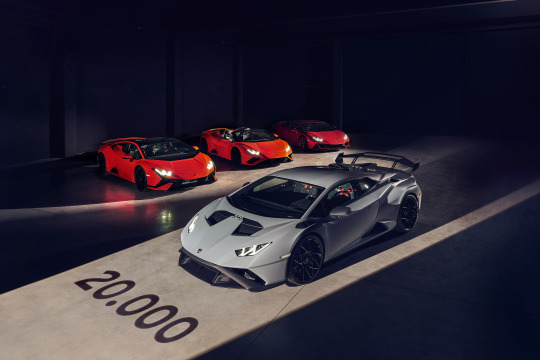
Huracan #20,000 Rolls Off Lamborghini Line
Automobili Lamborghini announces Huracán number 20,000: an STO model in glorious Grigio Acheso Matt for a client in the Principality of Monaco. While the Huracán Super Trofeo Omologata is the pinnacle of Huracán performance in a road car with racing spirit, it heads an extended family of Huracán models that have delivered aspirated performance with characterized dynamic handling and driving emotion since its 2014 launch.
Eight years’ success since 2014
The Huracán's success has endured for eight years, an attraction maintained over time thanks to a wide range of versions: 12 road and three racing versions. Since 2014, 71% of customers have chosen the coupé versions and 29% the open-air derivatives. Top of the markets is the United States, where more than 32% of all Huracán versions have been delivered in the last eight years, followed by the UK and Greater China. This solid success continues also today: Huracán models largely contributed to the 2021 sales record with a strong increase sales up to 2,586 units, due partly to the impetus from the very positive customer response to the Huracán STO.
2014: the first coupé version, LP 610-4
The first Huracán coupé (LP 610-4) debuted at the 2014 Geneva motor show with four-wheel drive, 610 hp, acceleration from 0-100 km/h of 3.2 secs and a top speed of 325 km/h. Innovations included Lamborghini ANIMA drive mode selection, on-board gyroscope LPI system, dual fuel injection and LEDs lights throughout the car: an industry first in the super sports segment. The Huracán LP 610-4 Spyder was unveiled at Frankfurt Motor Show in September 2015. The 5.2-litre naturally aspirated V10 is the same as in the coupé and develops 610 hp. The 0-100 km/h sprint is covered in 3.4 seconds and the top speed is 323 km/h.
2015: Huracán LP 580-2, a two-wheel drive experience
Compared to the LP 610-4, it differs in that it has a lower-powered engine and rear-wheel drive instead of all-wheel drive. It has the same 5.2-litre V10 as the 610-4 but with power reduced to 580 hp and torque of 533 Nm. Thanks to the absence of four-wheel drive, Lamborghini's engineers have achieved a weight saving of 33 kg compared to the Huracán coupé, at just 1,389 kg. Top speed is 320 km/h. A Spyder RWD variant of the Huracán LP 580-2 was unveiled at the Los Angeles Motor Show in November 2016. The 5.2-litre naturally aspirated V10 is the same as the coupe and develops 580 hp. A 250-off, limited edition Avio model in 2016, celebrated the aviation and aeronautic inspiration in Huracán styling.
2016: the Huracán Performante debut and the Nürburgring lap record
The 640 hp Huracán Performante stormed into markets in 2016: with Lamborghini’s patented ALA active aerodynamic innovations, it took the Nordschleife Nürburgring lap record for production cars and won awards around the world. In 2018, the Huracán Performante Spyder took the zenith of Huracán developments: the sublime combination of peerless technological innovation, performance and open-air driving. Like the Performante coupé, the Spyder outputs 640 hp at 8,000 rpm, producing 600 Nm of torque at 6,500 rpm, accelerating from 0-100 km/h in 3.1 seconds and 0-200 km/h in 9.3 seconds.
2019: the new Huracán EVO - the next generation V10 super sports car
In 2019, the Huracán EVO ‘evolution’ debuted. The distinctive design defined the aerodynamic superiority and enhanced driving dynamics of this new model taking the 640 hp and extraordinary abilities of the Performante combined with rear-wheel steering, torque vectoring and LDVI with predictive logic. The EVO Spyder adopted the next-generation vehicle dynamic control and aerodynamics developed for the coupé, with the 5.2-liter naturally aspirated Lamborghini V10 engine uprated for a higher power output and incorporating Titanium intake valves. In 2020, the Huracán EVO Rear-Wheel Drive (RWD) was presented delivering 610 hp of power at 8,000 rpm and 560 Nm of torque at 6,500 rpm to a lightweight car with rear-wheel drive and dynamic steering for maximum driving fun. The Huracán EVO RWD has a top speed of 325 km/h and accelerates from 0 to 100 km/h in 3.3 seconds. In the same year, Automobili Lamborghini was the first automotive brand to use Augmented Reality (AR) for the virtual launch of a new model, the Huracán EVO RWD Spyder. Using Apple’s AR Quick Look, the company brought its latest V10 super sports car directly to customers and fans worldwide.
2021: the Huracán STO – Lamborghini Squadra Corse at its heart
The Huracán STO (Super Trofeo Omologata) launched in 2021 delivered Lamborghini’s motorsport experience and know-how in a homologated road car. It has been inspired by the Huracán EVO Super Trofeo developed by Squadra Corse for Lamborghini’s own race series, as well as the Huracán EVO GT3, three-time winner of the 24 Hours of Daytona and two-time winner of the 12 Hours of Sebring. With its 640 hp naturally aspirated V10 engine generating 565 Nm at 6,500 rpm, the rear-wheel drive Huracán STO delivers exhilarating acceleration from 0 to 100 km/h in 3.0 seconds, from 0 to 200 km/h in 9.0 seconds, and a top speed of 310 km/h.
2022: the Huracán Tecnica, designed & engineered for both worlds
The latest in the Huracán family, unveiled in April 2022, is the Huracán Tecnica: the next-generation rear-wheel drive V10, developed for pilots seeking driving fun and lifestyle perfection on both road and track. The Tecnica’s moniker embodies the advanced evolution of the Huracan’s technical prowess and, instantly distinguishable as much a Huracán innovation externally as it is under the hood, with its new looks accenting improved aerodynamics for heightened performance, stability and ease of use, particularly on a circuit. Taking its engine from the Huracán STO, with an increase of 30 CV over the Huracán EVO rear-wheel drive (RWD), the powertrain delivers 565 Nm of torque at maximum 6,500 rpm and improved acceleration of 0-100 km/h in 3.2 seconds.
From connectivity to the digital world of E-sports
In 2021 Lamborghini became the first automaker to incorporate complete vehicle system control by Amazon Alexa in the Huracán EVO, and also first to adopt the what:three:words function for accurate navigation anywhere in the world. Lamborghini fans enjoy the Huracán in a host of video games and E-sports competitions including FORZA Horizon and Gran Turismo, Rocket League and Assetto Corsa Competizione.
60% of Huracáns feature Ad Personam customization
More than 60% of Huracáns delivered have featured Ad Personam customization drawing on a vast palette of colors, trims and special materials. The Ad Personam program now offers around 300 exterior colors, but a customer can always request a unique option. Customers in central Europe, Japan and UK are the most inclined to tailor-made customization. Everyday objects such as furniture, sofas, bags, clothes,
but also make-up (eye shadows, nail varnish), precious stones and watchstraps inspire Lamborghini customers. They need to feel free to create something that represents them: their tastes, personality and everyday life. A Huracán rear-wheel drive for the Pope was created in papal colors and presented in the Vatican City to be auctioned
for charity.
Huracán Polizia: a long-standing relationship with the Italian Police
Several Huracán’s have been delivered to the Italian police in a long-standing relationship: mainly used in medical emergencies, last year a Huracán delivered a transplant organ across 489 km from Padua to Rome in just over two hours.
Visitors touching down at Bologna’s Guglielmo Marconi airport have enjoyed the sight of Huracán follow-me cars leading planes onto aprons.
Huracán Adventures & Expeditions around the world
Huracáns have adventured across landscapes from Transylvania to the Scottish Highlands and Norwegian Lofoten islands, and amazed participants in Lamborghini Accademias on tracks and ice with their dynamic prowess.
From the road to the racetrack with Huracán Super Trofeo
The Huracán and its EVO successor have also created history on the racetrack. Almost 500 Huracán race cars have come off the production line in Super Trofeo and GT3 guise, including a limited Squadra Corse edition celebrating 10 years of Super Trofeo in 2019. Huracán GT3s have taken over than 40 championship titles and 117 victories in more than 12 series worldwide: Lamborghini is the only automaker to win the 24 Hours of Daytona GTD class three consecutive times, with the GT3 and GT3 EVO also winning the 24 Hours of Daytona and 12 Hours of Sebring double, two years in a row between 2018 and 2019.
87 notes
·
View notes
Text
FIFTEEN TESLA VEHICLES SET ALIGHT

11th September, Frankfurt Germany.
via: sansnom Translated by Act for freedom now!
“The International Motor Show (IAA) was held in Munich last week. At this summer show, all manner of multinationals were once again able to show off their gleaming, beautiful cars and congratulate themselves on their economic success in their air-conditioned conference rooms, limousines and exhibition halls.

So we torched a few new Tesla cars this evening in Frankfurt. In salute to the Munich protests. One of many attacks on the destructive automotive industry.
Tesla is one of our greatest enemies. This company represents better than any other the ideology of green capitalism and the pursuit of global and colonial destruction. Electric motors are constantly presented as the clean alternative. This is a cynical lie. Like other companies, Tesla exploits resources all over the world. The raw materials needed for electric car batteries, such as lithium and cobalt, are mined in Latin America or Africa under miserable conditions. Despite the pretty green paint job, fossil fuels are used to transport and extract them.
All this is linked to the oppression of indigenous communities, whose resistance must spur us to action.
Tesla accepts all this in order to produce cars that can slither through city centers. Which will show day after day that there is wealth to be had. But not for everyone. According to Tesla’s logic, only a few are entitled to own such cars. It’s a question of class that determines who drives or has the right to drive these cars.
This time, in a show of resistance, we attacked a parking lot housing Teslas for sale. Often, and just about everywhere, it’s Teslas belonging to private individuals that are hit, when it’s not the construction of its factories that are sabotaged, as in Berlin-Grünheide. All these acts are important to damage this group. Not only economically, but above all politically. To show that we don’t agree with the green lies, the plundering of raw materials or the cities and roads that belong only to the rich. In our opinion, these poisoners must pay a high price!
Tesla is part of a conglomerate of groups owned by Elon Musk. His patriarchal fantasies are apparently inexhaustible. He is one of those people who want to dominate the Internet, space, new technologies and artificial intelligence, and seems to know no limits to his fantasies of domination.
SpaceX, for example, is a company that wants to create more resources, rockets and spaceships to make space a vacation destination for the rich and advance the idea of one day inhabiting Mars. The appropriation and subjugation of territories for capitalism continues, all the way to Mars. A dystopia that speaks volumes.

But like SpaceX and Tesla, Neuralink also aspires to a longer-term perspective, in which individuals have a different value. In which some people have a right to a better life in the midst of the ecological catastrophe that is already upon us. Incorporating certain thoughts and ideas into the development of AI can only give rise to a deeply racist technology.
Some may claim that their electric cars are not responsible for the destruction of the world’s ecosystems, exploitation and displacement of populations. Some grant themselves the right to be blind to their privilege of colonial and ecological destruction. We must destroy these patriarchal and colonialist conceptions of the future. They are the enemy of a world and a way of life that are ecological and based on solidarity.
Greetings to all those on the run and in prison!
Switch Off – the system of destruction!”
#direct action#praxis#Frankfurt#Germany#anti civ#anti tech#anarchy#anarchism#protest#revolution#riot#ACAB#revolt
2 notes
·
View notes
Text
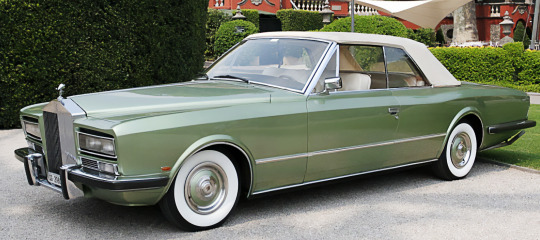
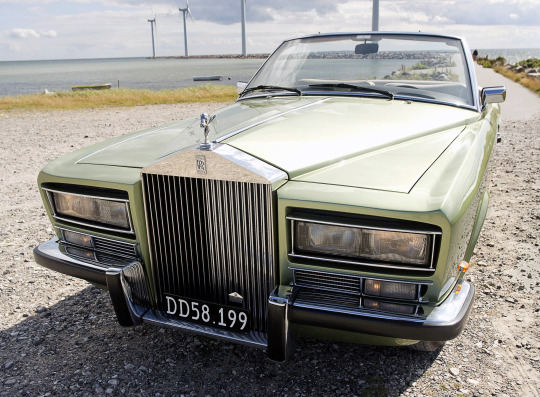


Rolls-Royce Phantom VI Drophead Coupé by Frua, 1973. Presented 50 years ago at the IAA in Frankfurt, a one-off Phantom convertible. The car had been ordered by H.E. Consul Simon van Kempen and had taken 2 years to build.
#Rolls-Royce#Rolls-Royce Phantom VI#IAA#1973#50 years ago#Frankfurt Motor Show#IAA73#one-off#Frau#coachbuilt#drophead coupé#open roof
697 notes
·
View notes
Photo
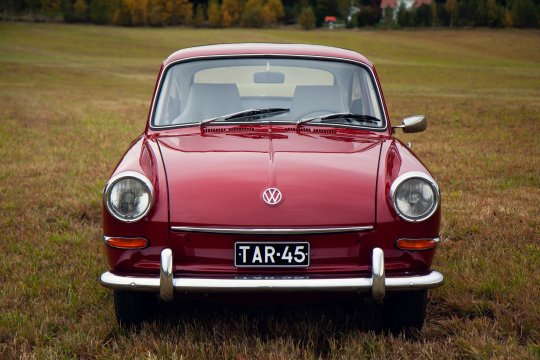
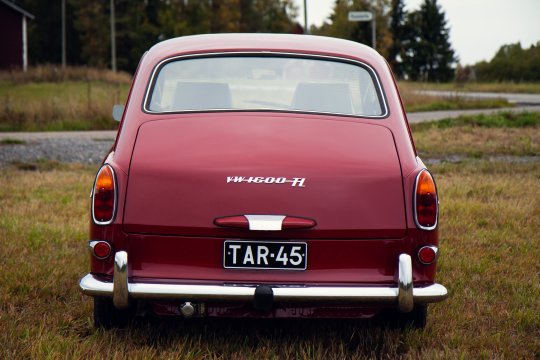
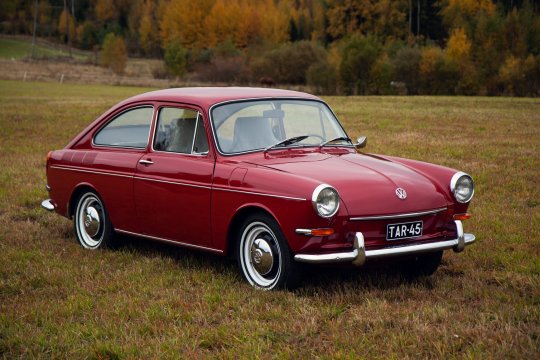






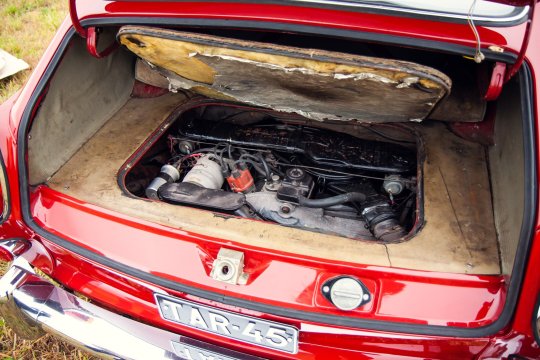
Volkswagen Typ 3 1600 TL Fastback
Towards the end of the 1950s, Volkswagen had a small family car in its collection, the Typ 1 Beetle, which had become a “ The People’s car”, Typ 2 vans and pick-up trucks, and the newly introduced coupé, Typ 14 Karmann-Ghia. A more spacious family car was missing, and the Typ 3 was designed to fill the gap. It was presented at the Frankfurt Motor Show in 1961.The Typ 3 was initially introduced under the Volkswagen 1500 model name, after the cubic capacity of the car’s engine. The technology of the car was once again familiar from Beetle, with an air-cooled engine placed at the back and rear-wheel drive. Compared to the Typ 1, the car was about 15 centimeters longer and offered better space for both passengers and luggage. The front suspension built with transverse torsion bars also made the ride more comfortable and civilized. The car was initially presented in two body styles, a three-door Notchback, and a three-door Variant. In 1966, the VW 1600 TL Fastback, a hatchback with a 1580 cubic meter engine, came available.
75 notes
·
View notes
Text

100 FORMULA E RACES
Covers off the Gen1 at the Frankfurt Motor Show - September 2013
14 notes
·
View notes
Photo

Nicholas Evans, who has died aged 72 after a heart attack, was the unlikely author of the bestselling novel The Horse Whisperer (1995), which became a Robert Redford film. Unlikely because the book, set in Montana, was a first novel by a British television producer, and landmark because the book sold for a record price at auction, and justified its sale price.
Evans had previously left a successful position as number two to Melvyn Bragg on the South Bank Show, where he produced many of the flagship programmes of the television arts series, including profiles of Patricia Highsmith, John Le Carré, Laurence Olivier, Francis Bacon and, most crucially, the film director David Lean, who became a friend and wondered why Evans was making a film about him, and not something he wanted to do for himself.
Evans then co-produced and wrote a TV film, Murder By the Book (1987), about Agatha Christie and her character Hercule Poirot, played by Peggy Ashcroft and Ian Holm. He wrote three screenplay adaptations, but by 1993 a film project had fallen through and he found himself £65,000 in debt and diagnosed with a stomach melanoma.
Evans had begun writing a novel based on a story that he had been told by a Devon blacksmith, who used the term “horse whisperer” to describe someone with a gift for communicating with horses. Evans had gone to the US, to meet men who did this, thinking the story needed a western setting. “If you set a book in postwar or contemporary Britain, something shrinks,” he said. “It becomes parochial.”
He gave the manuscript of the book, half-finished with an outline of the remainder, to his friend the agent Caradoc King, who took it to the 1994 Frankfurt book fair, where it instigated a bidding war.
Dell bought the US rights for $3.15m, Bantam got UK rights for $537,000 and translation deals in Germany and Italy netted another million dollars. The film rights went to Robert Redford for another $3m because Evans saw Redford in the role of his hero, Tom Booker.
While this was happening, his melanoma was removed by surgery and his local bank manager, who had been demanding repayment of his overdraft, called and invited him to lunch.
The novel got mixed reviews, especially in the US. Virtually no critic could resist mentioning Evans’ advances; many also drew comparison with Robert James Waller’s The Bridges of Madison County. Evans himself acknowledged the influences of Cormac McCarthy, Ernest Hemingway and Jack London. The New York Times critic Michiko Kakutani called it “a sappy romance novel, gussied up with some sentimental claptrap about the emotional life of animals and lots of Walleresque hooey about men and women”.
But it shot to the top of the New York Times’ bestseller list, ranked No15 for the year despite being released in the autumn, and remains one of the bestselling novels of all time. Redford’s 1998 film, which starred the 14-year-old Scarlett Johansson as Grace, the teenager injured along with her prize horse, and Kristin Scott Thomas as her mother, who seeks out Redford’s Booker, and has an affair with him, did well but was not a huge hit.
Evans was born in Bromsgrove, Worcestershire, the son of Anthony, the sales director of a motor engineering company, and Eileen (nee Whitehouse). He was head boy at Bromsgrove school, and after a year teaching in Senegal for Voluntary Service Overseas, went to St Edmund Hall, Oxford to study law, where he met Jenny Lyon, his future wife, in their first week.
After taking a first-class degree, he started work as a journalist for the Evening Chronicle in Newcastle. In 1975, he started at London Weekend Television, first on Weekend World and then the London Programme, the broadcaster’s top current affairs show, before joining the South Bank Show as executive producer from 1982 to 1984.
After Murder By the Book, he adapted screenplays for the TV movies Acts of Betrayal (1988), about the IRA, and Secret Weapon (1990), the story of Mordechai Vanunu, the nuclear bomb whistleblower kidnapped by the Israelis and imprisoned for treason, and for the Julie Walters film Just Like a Woman (1992), based on Monica Jay’s novel about a transvestite’s romance with his landlady.
His second novel, The Loop (1998), brought a wolf biologist, Helen Ross, from Cape Cod into Yellowstone Park to cope with the reintroduction of wolves; pursued by a local lothario, she instead romances his 18-year-old son and cures his stutter. It sold 5m copies.
He followed this up with The Smoke Jumper (2001), whose titular protagonist is in love with his best friend’s wife, and who exiles himself as a war photographer. Next came The Divide (2005), about a wealthy New York couple who holiday in Montana, where the body of their eco-terrorist daughter is discovered frozen in the mountain ice.
Evans and Jenny divorced in 1998. He then married the singer-songwriter Charlotte Gordon Cumming. In 2008, while on a visit to Gordon Cumming’s brother’s estate in Scotland, Evans picked mushrooms for a family lunch. What he thought were ceps were instead highly poisonous webcaps. Evans, Gordon Cumming and her brother were all placed on kidney dialysis. Three years later, Evans’s heart began to suffer under the strain of dialysis, and his daughter Lauren provided him with a kidney; Gordon Cumming later received one donated from a friend.
At the time of the poisoning, Evans had almost finished his fifth novel, The Brave (2009), about a family’s hidden secrets.
When he began writing again, thinking for the second time he needed to finish writing before he died, he said the book changed direction. “I found new empathy with the characters ... it became more emotional,” he said. Gordon Cumming released an album of songs tied to the novel, and they campaigned together for kidney care and organ transplants.
The couple lived in a 14th-century manor house in Devon once owned by the film director Robert Bolt.
Evans is survived by Charlotte, their children, Finlay and Lauren, a son, Max, from his first marriage, and by Harry, his son from a relationship with the television producer Jane Hewland.
🔔 Nicholas Benbow Evans, writer and television producer, born 26 July 1950; died 9 August 2022
Daily inspiration. Discover more photos at http://justforbooks.tumblr.com
9 notes
·
View notes
Text
It took several months of talks, including a secret meeting on the outskirts of Geneva (Switzerland) in which those present were not allowed to have cell phones or watches, until the deal had the green light to move forward. The final configuration of the unit would take place in Munich (Germany), at the end of 2018.
The unique technical characteristics of the Mercedes-AMG ONE meant that production start-up times were extended and it was only at the beginning of 2023, more than five years after the official announcement at the Frankfurt Motor Show, that the first unit rolled off the production line. assembly.
Given the artisanal nature of this authentic Formula 1 road car, the remaining examples have been delivered spaced out, with the unit delivered to the Portuguese client of Sociedade Comercial C. Santos arriving now, having already received, in March 2021, a Mercedes -AMG GT Black Series Edition ONE, exclusive for hyper sports car customers.
“Formula 1” road
The Mercedes-AMG ONE (combined cycle fuel consumption, weighted: 8.7 l/100 km; combined CO2 emissions: 198 g/km; combined electrical energy consumption: 32 kWh/100 km) is , in fact, a unique model that replicates the technology of a Formula 1 in a car that meets the legal requirements for approval to drive on public roads.
instagram
0 notes